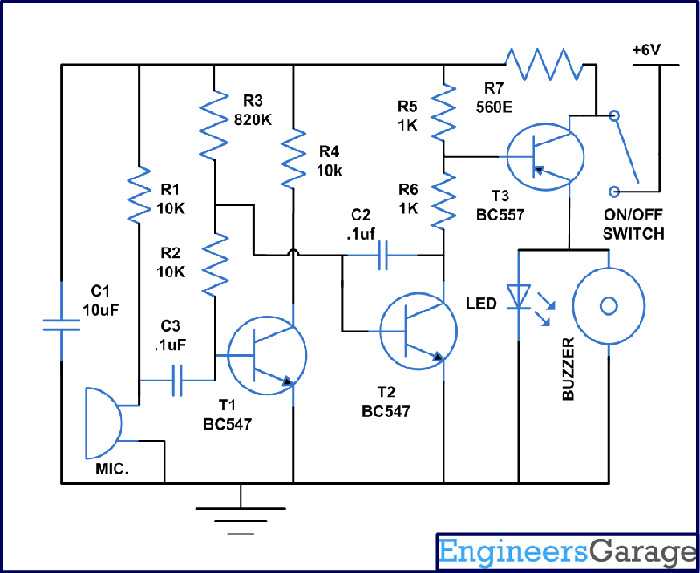It has become necessary to verify the identity of a person or visitor before opening the door as he may be a burglar. This switchless bell circuit will help you to identify who is standing at the door as it that activates through the puff of your breath or with a clap. Only those who know the place of secret bell would puff out before the hole of the switch box and now door can be opened without any fear.
Interestingly, this secret bell circuit does not use a microcontroller but only a BC547 transistor, a microphone, buzzer, switch, LED, a few resistors and capacitors.
This Transistor based secret bell circuit is based on the property of the transistor to amplify weak signals. In this, the condenser mic fitted inside a hole of a switch box will trigger the bell on detecting the change in air pressure as you clap or puff your breath.
As we know for proper working of a transistor the voltage at base region must be more positive than emitter region. Therefore when voltage is applied (through your puff) to a transistor, the emitter starts to supply electrons which get pulled by the base. This movement of electrons from emitter to collector creates a flow of electricity through the transistor. This current will pass from emitter to the collector through base. Hence by adjusting the voltage at base, the flow of current in the transistor can be change. In this way a small change in the base voltage can cause large in output.
Similarly, the front end of the circuit a condenser mic amplifier with fixed sensitivity is fixed. When you puff transistor T1 amplifies the signal received from the condenser mic through capacitor C1. When transistor T1 conducts, a short pulse is send to transistor T2 which again amplifies the signals and sends it to T3 for amplification. Through the collector region of T3, we have connected a LED and buzzer for audio visual output. If you want a loud sound you can also connect relay at output and through it you connect the bell. We have also provided a switch which turns OFF the bell when not in use to save your battery.
Circuit Diagrams
Project Components
Filed Under: Electronic Projects



Questions related to this article?
👉Ask and discuss on Electro-Tech-Online.com and EDAboard.com forums.
Tell Us What You Think!!
You must be logged in to post a comment.